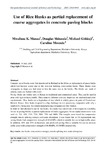Use of Rice Husks as partial replacement of coarse aggregates in concrete paving blocks

View/
Date
2020-07-31Author
Musau, Mwalimu K.
Shitanda, Douglas
Githinji, Michael
Mwende, Caroline
Metadata
Show full item recordAbstract
Concrete paver blocks were first introduced in Holland in the fifties as replacement of paver bricks
which had become scarce due to the post-war building construction boom. These blocks were
rectangular in shape and had more or less the same size as the bricks. The blocks are made of
cement, sand, and ballast with water.
Paving blocks are widely used in Kenya in residential and commercial areas. They can be used in
areas with light or heavy traffic. They come in different sizes and shapes as per structural and client
requirements. Rice husks are a byproduct of rice which is widely grown in parts of Central and
Western Kenya. Rice husks disposal is a big challenge in rice processing companies with only a
handful of it being used by cement manufacturing companies in t heir boilers.
In order to find alternative use of rice husks, this study was carried out to investigate its suitability
for use in paving blocks as partial replacement of coarse aggregates. Seven replacement ratios were
used viz: 5%, 10%, 15%, 25%, 50%, 75% and 100%. The samples were tested for compressive
strength, tensile splitting strength and water absorption. It was found that, at 5% replacement rate,
paving blocks had compressive strength of 65.61MPa which is suitable for use in high traffic areas.
In addition, 10% and 25% replacement rate produced paving blocks suitable for use in medium
traffic areas with compressive strength of 46.86MPa, 45.08MPa respectively.
